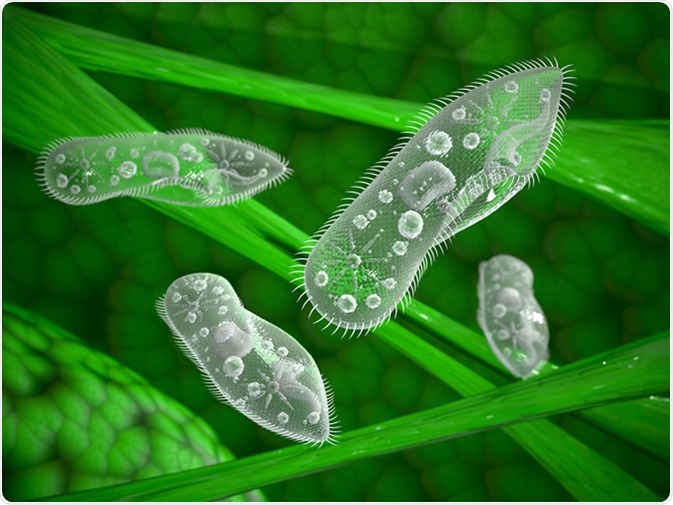For the past few decades, microbiology has mostly relied on bulk data. However, attempts to extract data from single cells have now been used to start understanding heterogeneous populations.
Single Cell Strategies
The evaluation single cell microbiology includes single cell imaging to understand and visualise cell organisation, cell division, infection, and biofilm growth. Apart from imaging, researchers are also beginning to use omics to study single-cell DNA, protein, RNA, and metabolites. As the vast microbial populations can be highly heterogeneous, single cell methods can provide valuable data for host pathogen interaction.

Paramecium protozoa. Image Credit: 3d_man / Shutterstock
Advantages of Single Cell Microbiology
Heterogeneity
Bulk populations of microbial communities can show genetic, biochemical, physiological, and behavioral heterogeneities. The microbial genomes can be plastic, where their genomes may undergo changes in short durations. Biochemical heterogeneity refers to differences in levels or activity of macromolecules and nucleic acids. Physiological heterogeneities arise from differences in size, shape, and other external or internal features. In a population, not all microorganisms may behave in the same manner due to differences in number and activity of signaling pathways. Thus, single cell methods can outline the phenotype of a single cell rather than the bulk behavior which may be a sum of different heterogeneous populations.
Characterizing dynamics events in single cells
Previously, microbial communities were considered to be “a homogenous solution of proteins”. However, it is now accepted that individual cells in a community show distinct behavioral and dynamic cellular events, which can be captured by single cell techniques.
Relating macroscopic and microscopic observations
The microbial populations show population level behaviors such as aggregation, pattern formations, and population-level behaviors. Using single cell methods it is now possible to understand these changes, at the level of single cells, which lead to global changes in behavior and coordination of the whole microbial populations.
Understanding cell-level processes
Different processes can only be understood further by analyzing at the level of single cell and not at the level of populations. These behaviors include gene distribution and transfer, and interactions between host and pathogen. The biochemical processes involved in these changes cannot be understood by analyzing the whole population. In such cases, studying the microbes at single-cell level is critical.
Identifying new viruses
Virologists are using single cell methods to identify new viruses. They are also using these methods to study the role of heterogeneity in viral infection and replication. Previously, the cell populations were synchronized to reduce heterogeneity but now those methods can be bypassed.
Disadvantages of Single Cell Microbiology
Challenges of microbial cytometry
Bacterium and viruses are very small. This leads to very low levels of DNA, RNA, and protein compared to eukaryotic cells. Bacterial RNA is also unstable and polyadenylated. This leads to further reductions in protein levels. Thus, very few papers have been published which show the RNA-seq of single bacterial cells.
Challenges in single cell sequencing
Most viruses and soil bacterium consist of high levels of GC content. This leads to problems in accurate sequencing of DNA. Also, using short-read sequencing to analyse the lysogenic bacteria is hard as they insert themselves in to the repetitive DNA sequences of the host.
Expensive
The tools used to perform single cell strategies are more expensive than the conventional methods. It requires flow cytometer, cleanroom, robotic liquid handler, and equipment to reduce contamination. Most of these tools are high cost and researchers end up invoking collaborations or using centralized facilities.
Further Reading
Last Updated: Feb 26, 2019